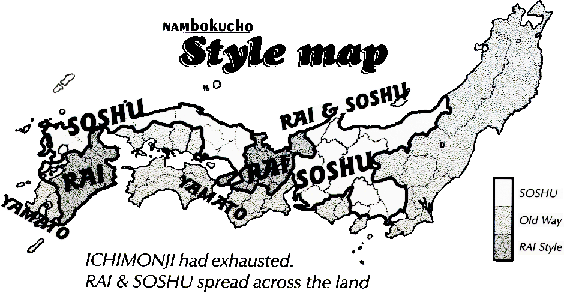|
SADAMUNE KEM-MU (t: MASAMUNE): From Omi (see Omi TAKAGI). Some say SADAMUNE
returned to Omi during the troubles. It is safe to say, all smiths
found travel an inviting alternative forward of 1332.
SADAMUNE: HIKOSHIRO. Born EI-NIN 6, 1298 and died SHO-HEI 4, 1349. Old writings
say KA-GEN 1303 to TEI-WA 1345 work span to find signed pieces. Today, people have
searched to find ZAIMEI-TO, real signed pieces, and of all swords found, not one is
said to be SHO-SHIN MEI. We see inscriptions of a KIKKO "Tortoise Shell" MON.
SADAMUNE DEN production proceeds from Late-KAMAKURA KA-REKI 1326 / GEN-TOKU 1329
through TEI-WA 1345. Today, it is felt that SADAMUNE DEN simply made MUMEI.
We see TACHI, TANTO and the KO-WAKIZASHI length, DAMBIRA for which SADAMUNE, and
his DEN, are famous.
First period; SUE-KAMAKURA KO-FURI TANTO.
NAMBOKUCHO style HIRA-TSUKURI, wide-bodied TANTO or elongated DAMBIRA, are many.
Remember: DAMBIRA = NAMBOKUCHO. SADAMUNE TANTO are elongated in the NAMBOKUCHO,
however, his version of NAMBOKU DAMBIRA is restrained. As the upper narrows slightly,
his is somewhat of a more gentle DAMBIRA SUGATA.
There are many NAMBOKU TACHI with wide MIHABA, shallow curve and O-KISSAKI.
He made ITAME HADA that shows MOKUME mixed within. HADA will be standing strongly.
There is CHIKEI.
KO-MIDARE to O-MIDARE HAMON forms that are NIE-DEKI in deep NIOI-FUKASHI. KINSUJI,
SUNAGASHI and TOBIYAKI are expected. Where MASAMUNE swords will have many YO, SADAMUNE
swords have occasional YO.
SADAMUNE special trait: His SUNAGASHI follows figures (which often follow HADA),
NOBUKUNI SUNAGASHI follows laminate lines and runs through GUNOME mounds,
parallel with the HA. This is the deciding point in KANTEI.
NIE and NIE HAKIKAKE BOSHI can be MIDARE with short turnback. O-MARU is seen.
HORIMONO of BONJI and SUKEN. UKIKEN (raised KEN) in a frame and KOSHI-HI, HI in the
waist, or double HI. BOHI and NIBI SUKEN balance a famous KATAKIRIBA.
FUNAGATA "Boat-Bottom" NAKAGO with KATTE SAGARI YASURI. SOSHU KENGYO JIRI or KURIJIRI.
MUMEI is the expected signature.

|
|